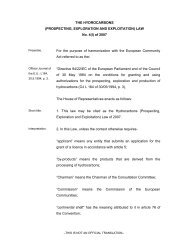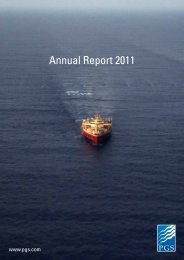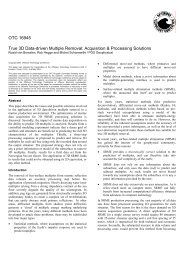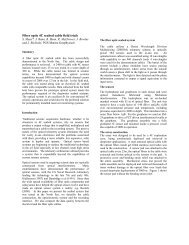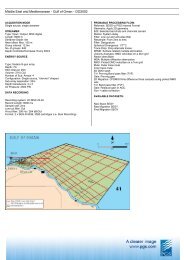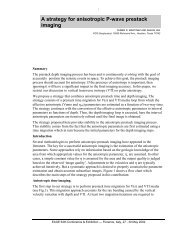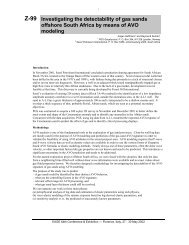joint velocity inversion for pp and ps prestack depth imaging - PGS
joint velocity inversion for pp and ps prestack depth imaging - PGS
joint velocity inversion for pp and ps prestack depth imaging - PGS
You also want an ePaper? Increase the reach of your titles
YUMPU automatically turns print PDFs into web optimized ePapers that Google loves.
1<br />
JOINT VELOCITY INVERSION FOR P-P AND P-S<br />
PRESTACK DEPTH IMAGING<br />
Yaohui Zhang*, Don Pham, Min Lou <strong>and</strong> Sheng Lee<br />
<strong>PGS</strong> Geophysical, 10550 Richmond Avenue, Houston, Texas, 77042 USA<br />
Summary<br />
We present a new <strong>velocity</strong> updating method <strong>for</strong> anisotropic P-P <strong>and</strong> P-S <strong>prestack</strong> <strong>depth</strong><br />
<strong>imaging</strong> via <strong>prestack</strong> <strong>joint</strong> <strong>velocity</strong> <strong>inversion</strong>. The <strong>joint</strong> <strong>velocity</strong> update consists of the<br />
estimation of vertical P- <strong>and</strong> S-wave velocities <strong>and</strong> anisotropic parameters in the transversely<br />
isotropic media with vertical symmetry (VTI). The near offset data is used <strong>for</strong> <strong>depth</strong><br />
consistent <strong>joint</strong> <strong>velocity</strong> <strong>inversion</strong> to estimate vertical <strong>depth</strong> <strong>and</strong> vertical P- <strong>and</strong> S-wave<br />
velocities. Integrating anisotropic parameters with <strong>depth</strong> consistent <strong>velocity</strong> model from<br />
vertical velocities completes the anisotropic <strong>prestack</strong> <strong>depth</strong> migration procedure. The results<br />
from synthetic data show that <strong>joint</strong> <strong>velocity</strong> update technique is an effective <strong>and</strong> practical<br />
a<strong>pp</strong>roach <strong>for</strong> multi-component <strong>depth</strong> <strong>imaging</strong>.<br />
Introduction<br />
Establishing <strong>and</strong> updating <strong>velocity</strong> models are two important ste<strong>ps</strong> <strong>for</strong> multi-component<br />
<strong>prestack</strong> seismic <strong>depth</strong> <strong>imaging</strong>. Anisotropic <strong>prestack</strong> <strong>depth</strong> migration requires predetermination<br />
of anisotropic parameters (Mikhailov etal. ,2001, Nolte etal, 1999, <strong>and</strong> Bale<br />
etal. ,1998). The key step in determining the required anisotropic parameters is to estimate the<br />
vertical velocities of P- <strong>and</strong> S-waves. There are two flows commonly used in conventional<br />
multi-component <strong>depth</strong> migration. The first flow commonly used in P-S <strong>prestack</strong> <strong>depth</strong><br />
migration is to assume that the <strong>depth</strong> model obtained from P-P migration is correct. The<br />
<strong>velocity</strong> updating is done only to the S-wave focusing <strong>velocity</strong> to flat the P-S events <strong>for</strong><br />
stacking. The results of migration will produce the same <strong>depth</strong> model. If there were an error in<br />
the P-wave <strong>depth</strong> model, the initial P-S image gathers may be incoherent <strong>and</strong> the updating of<br />
S-wave <strong>velocity</strong> field may be very difficult <strong>and</strong> unstable. The second flow takes the P-wave<br />
<strong>velocity</strong> as its down-going <strong>velocity</strong> field <strong>and</strong> updates the <strong>depth</strong> model with upcoming S-wave<br />
<strong>velocity</strong> field independent of P-wave model <strong>and</strong> <strong>velocity</strong>. Since the updating of <strong>depth</strong> model<br />
<strong>and</strong> S-wave <strong>velocity</strong> is independent of P-wave data, the outcome of the <strong>depth</strong> migration will<br />
show <strong>depth</strong> inconsistency between P-P <strong>and</strong> P-S images. In addition, both of these flows<br />
require the well log data to provide the vertical <strong>velocity</strong> in<strong>for</strong>mation <strong>for</strong> anisotropic <strong>prestack</strong><br />
<strong>depth</strong> migration. Neither flow offers a practical a<strong>pp</strong>roach to address the need of anisotropic<br />
<strong>depth</strong> migration.<br />
In this paper, we extend the a<strong>pp</strong>lication of post stack <strong>joint</strong> <strong>velocity</strong> <strong>inversion</strong> (Zhang etal.<br />
2001) to the <strong>velocity</strong> updating <strong>for</strong> multi-component seismic <strong>depth</strong> <strong>imaging</strong>. The <strong>joint</strong> <strong>velocity</strong><br />
<strong>inversion</strong> utilizes near offset data to estimate the vertical P- <strong>and</strong> S-wave velocities that are<br />
critical in determining anisotropic parameters <strong>for</strong> P-P <strong>and</strong> P-S <strong>depth</strong> migration in presence of<br />
VTI anisotropy. The combination of near <strong>and</strong> mid-offset data is used to estimate anisotropic<br />
parameters. In this paper, we use synthetic modeling to demonstrate our <strong>joint</strong> <strong>velocity</strong><br />
<strong>inversion</strong> procedure. Finally, we will show the practical aspects of this procedure with a real<br />
data example.<br />
EAGE 64th Conference & Exhibition — Florence, Italy, 27 - 30 May 2002
2<br />
Theory <strong>and</strong> Methodology<br />
The proposed multi-component <strong>prestack</strong> <strong>depth</strong> migration flow is as following:<br />
(1) Build initial P-P <strong>and</strong> P-S <strong>velocity</strong> models <strong>and</strong> per<strong>for</strong>m isotropic <strong>prestack</strong> <strong>depth</strong> migration<br />
<strong>for</strong> near offset P-P <strong>and</strong> P-S data.<br />
(2) Per<strong>for</strong>m <strong>joint</strong> <strong>inversion</strong> on the migrated data to derive the vertical velocities that tie the<br />
<strong>depth</strong> of P-P <strong>and</strong> P-S images. The output from the <strong>inversion</strong> procedure will be the vertical<br />
<strong>depth</strong>, Z 0 , vertical P-wave <strong>velocity</strong>, Vp 0 , <strong>and</strong> vertical S-wave velocities, Vs 0 .<br />
(3) Update <strong>velocity</strong> model <strong>and</strong> re-run <strong>prestack</strong> <strong>depth</strong> migration <strong>for</strong> the same data. The<br />
resulting images between P-P <strong>and</strong> P-S should be <strong>depth</strong> consistent.<br />
(4) Use the <strong>velocity</strong> model obtained in step 3 to per<strong>for</strong>m <strong>prestack</strong> <strong>depth</strong> migration <strong>for</strong> near to<br />
mid-offset data. If all <strong>depth</strong> image gathers are flat, then the data is isotropic <strong>and</strong> anisotropic<br />
processing is not required. If the image gathers are not flat, then anisotropy is implied.<br />
(5) Per<strong>for</strong>m anisotropic parameter estimation.<br />
Vp 0 ,Vs 0 ,Z 0<br />
Vp N,Z <strong>pp</strong><br />
Vp N,Vs N,Z <strong>ps</strong><br />
Vertical <strong>depth</strong><br />
∆Z<strong>pp</strong><br />
∆Z<strong>ps</strong><br />
Isotropic P-P image<br />
Figure 1. The mismatches between isotropic P-P <strong>and</strong> P-S images <strong>and</strong> vertical <strong>depth</strong> in the VTI<br />
medium.<br />
Our strategy <strong>for</strong> the anisotropic parameter estimation is depicted in Figure 1. We first per<strong>for</strong>m<br />
P-P isotropic <strong>velocity</strong> focusing using the <strong>velocity</strong> model derived in step 3. Second, we stack<br />
the data <strong>and</strong> measure the <strong>depth</strong>, Z <strong>pp</strong> (see Figure 1). Third, we measure the <strong>depth</strong> difference<br />
between the vertical <strong>depth</strong> (Z 0 ) <strong>and</strong> isotropic P-P <strong>depth</strong> (Z <strong>pp</strong> ). Finally, we use this in<strong>for</strong>mation<br />
to estimate the anisotropic parameter δ that can be expressed, to the first order a<strong>pp</strong>roximation,<br />
as<br />
Z <strong>pp</strong> − Z 0 ∆Z<br />
<strong>pp</strong><br />
δ ≈ = .<br />
Z 0 Z 0<br />
where Z 0 is the vertical <strong>depth</strong> given by <strong>joint</strong> <strong>velocity</strong> <strong>inversion</strong> in step 2. Similarly, <strong>for</strong> the P-S<br />
anisotropic parameter, σ, we can a<strong>pp</strong>roximate it by the following expression<br />
∆Z<br />
2 <strong>pp</strong> 2 γ ∆Z<br />
0 <strong>pp</strong><br />
σ ≈ γ 0 ( ) [ + 1]<br />
Z 2 Z<br />
0<br />
where γ 0 (=Vp 0 /Vs 0 ) is the ratio of the vertical P-wave <strong>velocity</strong> to the vertical S-wave<br />
<strong>velocity</strong>. Once these anisotropic parameters are determined, we can per<strong>for</strong>m the final<br />
anisotropic <strong>prestack</strong> <strong>depth</strong> migration that requires Vp 0 , Vs 0 , δ, <strong>and</strong> σ.<br />
In summary, the <strong>depth</strong> consistent <strong>joint</strong> <strong>velocity</strong> <strong>inversion</strong> provides three critical parameters <strong>for</strong><br />
the estimation of anisotropic parameters in presence of anisotropy: the vertical <strong>depth</strong>, Z 0 ,<br />
vertical P-wave <strong>velocity</strong>, Vp 0 , <strong>and</strong> vertical S-wave velocities, Vs 0 .<br />
0<br />
Isotropic P-S image
3<br />
Data Example<br />
We a<strong>pp</strong>lied the <strong>joint</strong> <strong>velocity</strong> update method to anisotropic synthetic data to demonstrate that<br />
the vertical <strong>depth</strong>, P- <strong>and</strong> S-wave velocities can be determined within error tolerance. We<br />
believe that the near offset data is sufficient <strong>for</strong> the estimation of the vertical velocities. We<br />
used a ray-tracing method to create the synthetic data with the P- <strong>and</strong> S-wave <strong>velocity</strong> models<br />
shown in Figure 2. We introduced anisotropic (VTI) in the first layer. Figure 3 shows the<br />
initial <strong>depth</strong> migrated sections of the anisotropic P-P <strong>and</strong> P-S data be<strong>for</strong>e <strong>joint</strong> <strong>velocity</strong><br />
<strong>inversion</strong>. We migrated these images with the initial P-wave <strong>velocity</strong> model that has an error<br />
of 12% <strong>and</strong> the initial S-wave <strong>velocity</strong> model that has error of 7.5%. We then measured the<br />
<strong>depth</strong> mismatch <strong>for</strong> the <strong>joint</strong> <strong>inversion</strong> to determine the <strong>depth</strong> consistent <strong>velocity</strong> fields. The<br />
estimated vertical velocities from the <strong>joint</strong> <strong>inversion</strong> are within 2% errors of the correct<br />
velocities. With these velocities, we re-run the <strong>depth</strong> migration <strong>for</strong> the same input data. The<br />
results are shown in Figure 4. There is an excellent tie in <strong>depth</strong> between P-P <strong>and</strong> P-S <strong>depth</strong><br />
migrated sections. The consistency between exact model (Figure 2) <strong>and</strong> the <strong>joint</strong> <strong>inversion</strong><br />
<strong>depth</strong> results (Figure 4) demonstrates that we can determine the vertical P- <strong>and</strong> S-wave<br />
velocities from the near offset anisotropic data. Based on the estimated vertical parameters,<br />
we proceed to estimate the anisotropic parameters as outlined above.<br />
5.0KM<br />
5.0KM<br />
0.5<br />
0.5<br />
1.0<br />
1.0<br />
1.5<br />
1.5<br />
D<br />
ep<br />
th<br />
(K<br />
M)<br />
2.0<br />
2.5<br />
3.0<br />
D<br />
ep<br />
th<br />
(K<br />
M)<br />
2.0<br />
2.5<br />
3.0<br />
Figure 2. P- <strong>and</strong> S-wave synthetic models.<br />
P-P<br />
P-S<br />
Figure 3. Initial <strong>depth</strong> images of near offset P-P <strong>and</strong> P-S data be<strong>for</strong>e <strong>joint</strong> <strong>inversion</strong> <strong>for</strong> VTI.<br />
P-P<br />
P-S<br />
Figure 4. Final <strong>depth</strong> images of near offset P-P <strong>and</strong> P-S data after <strong>joint</strong> <strong>inversion</strong> <strong>for</strong> VTI.<br />
EAGE 64th Conference & Exhibition — Florence, Italy, 27 - 30 May 2002
4<br />
(a)<br />
(b)<br />
Figure 5. (a) Depth consistent P-P <strong>and</strong> P-S image gathers by <strong>joint</strong> <strong>inversion</strong> <strong>for</strong> vertical velocities; (b)<br />
focused P-P <strong>and</strong> P-S <strong>depth</strong> images using mid-offset data.<br />
Figures 5a shows the <strong>depth</strong> consistent P-P <strong>and</strong> P-S image gathers of the anisotropic data. The<br />
flattened gathers are shown in Figure 5b. The <strong>depth</strong> consistency <strong>and</strong> focusing cannot exist<br />
simultaneously from isotropic processing. We can use the <strong>depth</strong> mismatch between the<br />
vertical <strong>depth</strong> <strong>and</strong> the isotropic P-P <strong>depth</strong> to estimate the anisotropic parameters from as<br />
outlined above. The estimated values of δ <strong>and</strong> σ are 0.09 <strong>and</strong> 0.619 which have a 10% error<br />
compared to the exact values of 0.1 <strong>and</strong> 0.693, respectively.<br />
Conclusions<br />
We present a practical a<strong>pp</strong>roach <strong>for</strong> the <strong>joint</strong> <strong>velocity</strong> update method to estimate anisotropic<br />
parameters <strong>for</strong> multi-component <strong>depth</strong> <strong>imaging</strong>. We use the near offset data to check <strong>for</strong> the<br />
<strong>depth</strong> consistency <strong>and</strong> to estimate vertical velocities. We also use the mid-offset data <strong>for</strong><br />
focusing analysis to estimate the isotropic P-P <strong>depth</strong>. The combination of the <strong>joint</strong> <strong>velocity</strong><br />
<strong>inversion</strong> <strong>and</strong> the focusing analysis allows us to calculate anisotropic parameters directly in<br />
the <strong>depth</strong> domain. As a consequence, it is more stable <strong>and</strong> easy to tie with well log data <strong>for</strong><br />
reservoir interpretation. Finally, using <strong>joint</strong> <strong>inversion</strong> to estimate the vertical P- <strong>and</strong> S-wave<br />
velocities are very useful <strong>for</strong> anisotropic <strong>depth</strong> migration when well log data is not available.<br />
Acknowledgements<br />
We would like to thank Jerry Yuan <strong>for</strong> many useful discussions <strong>and</strong> suggestions. We thank<br />
Hongwei Wang <strong>for</strong> creating synthetic data <strong>and</strong> Shelton Ma <strong>for</strong> helping with the anisotropic<br />
ray tracing. Finally, we thank <strong>PGS</strong> <strong>for</strong> the permission to publish this work.<br />
References<br />
Bale, R. A., Farmer, P., Hansen, J. O., Nichols, D. E. <strong>and</strong> Palacharla, G. K., 1998, Prestack <strong>depth</strong><br />
migration of converted wave data in anisotropic media, 68th Ann. Internat. Mtg: Soc. of Expl.<br />
Geophys., 1108-1111.<br />
Mikhailov, O. V., Johnson, J., Shoshitaishvili, E. <strong>and</strong> Frasier, C., 2001, Practical a<strong>pp</strong>roach to <strong>joint</strong><br />
<strong>imaging</strong> of multi-component data: The Leading Edge, 20, no. 9, 1016-1021.<br />
Nolte, B., Bishop, K. <strong>and</strong> Sukup, D., 1999, Anisotropic <strong>prestack</strong> <strong>depth</strong> migration of converted-wave<br />
data from the Gulf of Mexico, 69th Ann. Internat. Mtg: Soc. of Expl. Geophys., 691-694.<br />
Zhang, Y., Pham, L. <strong>and</strong> Neves, F., 2001, Depth-consistent P-P <strong>and</strong> P-S seismic image via <strong>joint</strong><br />
<strong>velocity</strong> <strong>inversion</strong>, 71st Ann. Internat. Mtg: Soc. of Expl. Geophys., 841-844.



